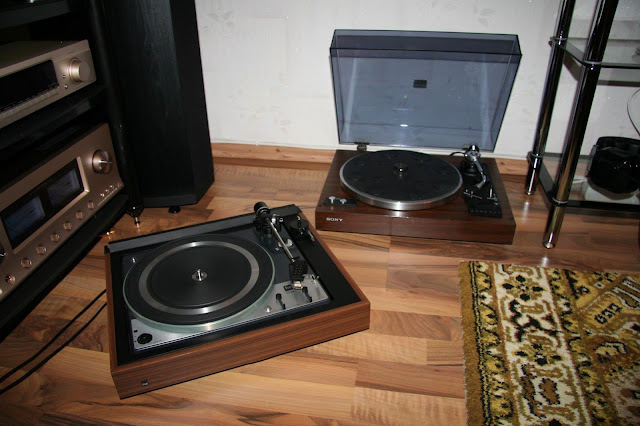This Blog Dedicated To Golden Age Of Audio: Vintage HI-Fi Audio From The 60s, 70s,80s,90s.
Thursday, 26 January 2012
Sansui QRX-7500A Quadro Receiver
1974 One of the biggest quadrophonic receivers from Sansui ever made
Weight 27 kg
Weight 27 kg
35 watt per channel x4
Photo from:
Monday, 23 January 2012
Technics ST 9600 Stereo Tuner
Technics ST 9600 Stereo Tuner
1976
The ST-9600 is the tuner from the first series of Technics high-end components in the dark design and 19" versions of the 70's. A five gang variable capacitor secures sensitive, selective sharp reception. Everything on board is what makes a quality tuner.
The high engineering effort in design is typical for the time when the used material apparently played no role. The carefully attached real dialglass and solid aluminum front panel is a highlight for the eyes in the living area.
Dominated by the 19-inch handles are typical left and right. Technics has been able to set the time, even without the trendy blueface design (blackout-scale) is a milestone in the serious hi-fi segment. A true classic in the typical Technics look.
Photos from: http://www.flickr.com/photos/48136705@N05/
1976
The ST-9600 is the tuner from the first series of Technics high-end components in the dark design and 19" versions of the 70's. A five gang variable capacitor secures sensitive, selective sharp reception. Everything on board is what makes a quality tuner.
The high engineering effort in design is typical for the time when the used material apparently played no role. The carefully attached real dialglass and solid aluminum front panel is a highlight for the eyes in the living area.
Dominated by the 19-inch handles are typical left and right. Technics has been able to set the time, even without the trendy blueface design (blackout-scale) is a milestone in the serious hi-fi segment. A true classic in the typical Technics look.
Photos from: http://www.flickr.com/photos/48136705@N05/
The Pioneer PL-12D
| The Pioneer PL-12D |
In the mid seventies, when vinyl was what CD is today, record decks were plentiful. They were made in every imaginable form, from the cheap and nasty to the expensive and Some decks came with the parallel tracking arm system such as the Revox, but the majority were of the pivoted variety. Others decks were produced without an arm (or plinth come to that), giving the discerning hi-fi buyer complete choice. If you wanted to buy a record deck in those As ever, with hindsight, it's quite easy to look back and recognise what was good, because all the choices and decisions have now been made. Garrard, Leak, Dual, Thorens and Linn One unlikely success story that stands out from this period was the Pioneer PL-12D. This deck, certainly looking the part with its wood grain effect plinth, and sleek design, turned out to be a big hit, I think everyone looking for a reasonably priced deck with excellent specification at that time, had one, (myself included), they were everywhere! The Pioneer ads of the day stated that; 'The famous The PL-12D, is a belt drive system with an aluminium one piece platter, which comes with a choice of two speeds, 33 and 45 rpm; a manual action 'S' shaped tone arm, a SME style screw-on headshell and a detachable Perspex lid. Though the 'Anti- The motor is suspended under the chassis and is seated on an arrangement of rubber insulators that ensure that there is no metal-to-metal contact between them. Retro. http://www.retrohifi.co.uk/pioneer_pl12d.html |
Thursday, 19 January 2012
Subscribe to:
Comments (Atom)







